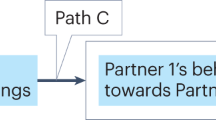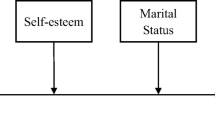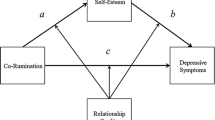Abstract
This research investigated the extent to which low self-esteem, relationship dissatisfaction, and relationship insecurity exacerbate intention to break up in romantic relationships. Results from the study indicated that low self-esteem contributed to individuals having negative thoughts, emotions, and evaluation of their romantic relationships. Quite importantly, findings in the study showed that insecurity and relationship dissatisfaction partially mediate the relationship between low self-esteem and intention to break up in romantic relationships. Findings also indicated that due to low self-esteem, individuals may begin to doubt the level of trust, love and care accorded them by their romantic partners.

Similar content being viewed by others
Data Availability Statement
The datasets generated during and/or analysed during the current study are available from the corresponding author on reasonable request.
References
Abdel-Khalek, A. M. (2016). Introduction to the psychology of self-esteem. In F. Holloway (Ed.), Self-esteem; perspectives, influences and improvement strategies (pp. 1–23). NewYork: Nova Publishers.
Ackerman, R. A., Witt, E. A., Donnellan, M. B., Trzesniewski, K. H., Robins, R. W., & Kashy, D. A. (2011). What does the narcissistic personality inventory really measure? Assessment, 18(1), 67–87. https://doi.org/10.1177/1073191110382845.
Aldeis, D., & Afifi, T. D. (2015). Putative secrets and conflict in romantic relationships over time. Communication Monographs, 82(2), 224–251. https://doi.org/10.1080/03637751.2014.986747.
Anderson, J. C., & Gerbing, D. W. (1988). Structural equation modeling in practice: A review and recommended two-step approach. Psychological Bulletin, 103(3), 411.
Arbuckle, J. L. (2014). Amos 23.0 user’s guide. Chicago: IBM SPSS.
Arikewuyo, A. O., Bahire, O., & Lasisi, T. (2019). Erotic use of social media pornography in gratifying romantic relationship desires. The Spanish Journal of Psychology, 1(2), 1–20. https://doi.org/10.1017/sjp.2019.60.
Arikewuyo, A. O., Efe-Özad, B., & Owolabi, A. S. (2020). 9:‘I U’: A semiotic analysis of romantic relationship Bitmojis on social media. It Happened, 134.
Arikewuyo, A. O., Efe-Özad, B., Dambo, T. H., Abdulbaqi, S. S., & Arikewuyo, H. O. (2020). An examination of how multiple social media platforms influence romantic relationships. Journal of Public Affairs. https://doi.org/10.1002/pa.2240.
Arikewuyo, A. O., Eluwole, K. K., & Ozad, B. (2020). Influence of lack of trust on romantic relationship problems: The mediating role of partner cell phone snooping. Psychological Reports, 12(10), 1–10. https://doi.org/10.1177/0033294119899902.
Arikewuyo, A., Ozad, B., Abdulbaki, S. S., Okoji, T., & Oloyede, D. (2019). Social media pornography consumption in achieving satisfaction in romantic relationships. International Journal of Information Processing and Communication,(IJIPC), 7(1), 60–71.
Attridge, M., Berscheid, E., & Sprecher, S. (1998). Dependency and insecurity in romantic relationships: Development and validation of two companion scales. Personal Relationships, 5(1), 31–58.
Bagozzi, R. P., & Yi, Y. (1988). On the evaluation of structural equation models. Journal of the Academy of Marketing Science, 16(1), 74–94.
Baumeister, R. F., Campbell, J. D., Krueger, J. I., & Vohs, K. D. (2003). Does high self-esteem cause better performance, interpersonal success, happiness or healthier lifestyles. Psychological Science in the Public Interest, 4(1), 1–44. https://doi.org/10.1111/1529-1006.01431.
Brassard, A., Dupuy, E., Bergeron, S., & Shaver, P. R. (2015). Attachment insecurities and women's sexual function and satisfaction: The mediating roles of sexual sex-esteem, sexual anxiety and sexual assertiveness. Journal of Sex Research, 52(1), 110–119. https://doi.org/10.1080/00224499.2013.838744.
Campbell, L., & Stanton, S. C. (2019). Adult attachment and trust in romantic relationships. Current Opinion in Psychology, 25, 148–151. https://doi.org/10.1016/j.copsyc.2018.08.004.
Campbell, L., Balzarini, R. N., Kohut, T., Dobson, K., Hahn, C. M., Moroz, S. E., & Stanton, S. C. (2017). Self-esteem, relationship threat, and dependency regulation: Independent replication of Murray, Rose, Bellavia, Holmes, and Kusche (2002) study 3. Journal of Research in Personality., 72, 5–9. https://doi.org/10.1016/j.jrp.2017.04.001.
Caughlin, J. P., & Golish, T. D. (2002). An analysis of the association between topic avoidance and dissatisfaction: Comparing perceptual and interpersonal perceptions. Communication Monographs, 69(4), 275–295. https://doi.org/10.1080/03637750216546.
Cramer, D. (2004). Emotional support, conflict, depression, and relationship satisfaction in a romantic partner. The Journal of Psychology, 138(6), 532–542. https://doi.org/10.3200/JRLP.138.6.532-542.
Cunningham, M. R., Shamblen, S. R., Barbee, A. P., & Ault, L. K. (2005). Social allergies in romantic relationships: Behavioral repetition, emotional sensitization and dissatisfaction in dating couples. Personal Relationships, 12, 273–295.
DeHart, T., Pelham, B., & Murray, S. (2004). Implicit dependency regulation: Self-esteem, relationship closeness, and implicit evaluations of close others. Social Cognition, 22(1), 126–146. https://doi.org/10.1521/soco.22.1.126.30986.
DeHart, T., Tennen, H., Armeli, S., Todd, M., & Affleck, G. (2008). Drinking to regulate negative romantic relationship interactions: The moderating role of self-esteem. Journal of Experimental Social Psychology, 44, 527–538. https://doi.org/10.1016/j.jesp.2007.10.001.
Eluwole, K. K., Lasisi, T. T., Elidemir, S. N., & Guzel, E. (2019). Qualitative investigation of the impact of internationalization of education on host community's eating habit. Journal of Public Affairs, 20, e2036. https://doi.org/10.1002/pa.2036.
Emler, N. (2001). Self-esteem; the costs and causes of low self-worth. York: York Publishing services.
Erol, R. Y., & Orth, U. (2013). Actor and partner effects of self-esteem on relationship satisfaction and the mediating role of secure attachment between partners. Journal of Research in Personality, 47, 26–35. https://doi.org/10.1016/j.jrp.2012.11.003.
Erol, R. Y., & Orth, U. (2014). Development of self-esteem and relationship satisfaction in couples: Two longitudinal studies. Developmental Psychology, 50, 2291–2303. https://doi.org/10.1037/a0037370.
Erol, R. Y., & Orth, U. (2016). Self-esteem and the quality of romantic relationships. European Psychologist, 21, 274–283. https://doi.org/10.1027/1016-9040/a000259.
Eyre, S. L., Milbrath, C., & Peacock, B. (2007). Romantic relationships trajectories of African American gay/bisexual adolescents. Journal of Adolescent Research, 22(2), 107–131. https://doi.org/10.1111/j.1467-8624.2008.01226.x.
Fanaj, N., & Melonashi, E. (2014). A systematic literature review on self-esteem and psychological well-being in Kosovo. Human and Social Sciences at the Common Conference, pp. 103–108.
Feiring, C., Simon, V. A., & Markus, J. (2018). Narratives about specific romantic conflicts: Gender and associations with conflict beliefs and strategies. Journal of Counseling & Development, 96, 254–266. https://doi.org/10.1002/jcad.12200.
Fraley, R. C., & Shaver, P. R. (2000). Adult romantic attachment: Theoretical developments, emerging controversies and unanswered questions. Review of General Psychology, 4(2), 132–154. https://doi.org/10.1037/1089-2680.4.2.132.
Gere, J., & Impett, E. A. (2018). Shifting priorities: Effects of partners’ goal conflict on goal adjustment processes and relationship quality in developing romantic relationships. Journal of Social and Personal Relationships, 35(6), 793–810. https://doi.org/10.1177/0265407517698851.
Gerlach, T. M., Driebe, J. C., & Reinhard, S. K. (2018). Personality and romantic relationship satisfaction. In V. Zeigler-Hill & T. K. Shackelford (Eds.), Encyclopedia of personality and individual differences. New York: Springer International Publishing. https://doi.org/10.1007/978-3-319-28099-8_718-1.
Greenberger, E., Chen, C., Dmitrieva, J., & Farruggia, S. P. (2003). Item-wording and the dimensionality of the Rosenberg self-esteem scale: do they matter? Personality and Individual Differences, 35(6), 1241–1254. https://doi.org/10.1016/S0191-8869(02)00331-8.
Holden, C. J., Zeigler-Hill, V., Shackelford, T. K., & Welling, L. L. (2018). The impact of relationship-contingent self-esteem on mate retention and reactions to threat. Personal Relationships, 25(4), 611–630. https://doi.org/10.1111/pere.12255.
IBM Corp. (2013). IBM SPSS statistics for windows, version 22.0. Armonk, NY: IBM Corp Released 2013.
Kansky, J. (2018). What's love got to do with it?: Romantic relationships and well-being. Handbook of well-being. Salt Lake City, UT: DEF Publishers nobascholar.com.
Kawamoto, T., Nittono, H., & Ura, M. (2015). Trait rejection sensitivity is associated with vigilance and defensive response rather than detection of social rejection cues. Frontiers in Psychology, 6, 1516. https://doi.org/10.3389/fpsyg.2015.01516.
Kim, J. S., Weisberg, Y. J., Simpson, J. A., Oriña, M. M., Farell, A. K., & Johnson, W. F. (2015). Ruining it for both of us: The disruptive role of low-trust partners on conflict resolution in romantic relationships. Social Cognition, 33(5), 520–542. https://doi.org/101521soco2015335520.
Klosterman, M. (2012). Self-esteem and relationship perception. Ursidae: The Undergraduate Research Journal at the University of Colorado, 2(2), 97–103.
Lachmann, S. (2013). How to mourn a breakup to move past grief and withdrawal. Psychology Today.
Lasisi, T. T., Alola, A. A., Eluwole, K. K., Ozturen, A., & Alola, U. V. (2020). The environmental sustainability effects of income, labour force, and tourism development in OECD countries. Environmental Science and Pollution Research, 27, 1–12. https://doi.org/10.1007/s11356-020-08486-w.
Lasisi, T. T., Ozturen, A., Eluwole, K. K., & Avci, T. (2020). Explicating innovation-based human resource management's influence on employee satisfaction and performance. Employee Relations: The International Journal, 42(6), 1181–1203. https://doi.org/10.1108/ER-08-2019-0319.
Lerner, J. S., Li, Y., Valdesolo, P., & Kassam, K. S. (2015). Emotion and decision making: Online supplement. Annual Review of Psychology, 66, 33–31. https://doi.org/10.1146/annurev-psych-010213-115043.
Luerssen, A., Jhita, G. J., & Ayduk, O. (2017). Putting yourself on the line: Self-esteem and expressing affection in romantic relationships. Personality and Social Psychology Bulletin, 43(7), 940–956. https://doi.org/10.1177/0146167217702374.
Marigold, D. C., Holmes, J. G., & Ross, M. (2010). Fostering relationship resilience: An internvention for low self-esteem individuals. Journal of Experimental Social Psychology, 46, 624–630. https://doi.org/10.1016/j.jesp.2010.02.011.
Martins, T. C., Canavarro, M. C., & Moreira, H. (2015). Adult attachment insecurity and dyadic adjustment: The mediating role of criticism. Psychology and Psychotherapy, 88(4), 378–393. https://doi.org/10.1111/papt.12055.
Mathes, E. W., & Severa, N. (1981). Jealousy, romantic love, and liking: Theoretical considerations and preliminary scale development. Psychological Reports, 49(1), 23–31.
Merrill, A. F., & Afifi, T. D. (2017). Couple identity gaps, the management of conflict, and biological and self-reported stress in romantic relationships. Human Communication Research, 43, 363–396. https://doi.org/10.1111/hcre.12110.
Miga, E. M., Hare, A., Allen, J. P., & Manning, N. (2010). The relation of insecure attachment states of mind and romantic attachment styles to adolescent aggression in romantic relationships. Attachment & Human Development, 12(5), 463–481. https://doi.org/10.1080/14616734.2010.501971.
Mogilski, J. K., Vrabel, J., Mitchell, V., & Welling, L. L. (2019). The primacy of trust within romantic relationships: Evidence from conjoint analysis of HEXACO-derived personality profiles. Evolution and Human Behavior, 40, 365–374. https://doi.org/10.1016/j.evolhumbehav.2019.04.001.
Murray, S. L., Gomillion, S., Holmes, J. G., & Harris, B. (2015). Inhibiting self-protection in romantic relationships: Automatic partner attitudes as a resource for low self-esteem. Social Psychology and Personality Science, 6(2), 173–182. https://doi.org/10.1177/1948550614549386.
Murray, S. L., Holmes, J. G., Griffin, D. W., Bellavia, G., & Rose, P. (2001). The mismeasure of love: How self-doubt contaminates relationship beliefs. Personality And Social Psychology Bulletin 2001, 27(4), 423–436. https://doi.org/10.1177/0146167201274004.
Murray, S. L., Paul, R., Bellavia, G. M., Holmes, J. G., & Garrett, A. K. (2002). APAPsycNet.
Nongpong, S., & Charoensukmongkol, P. (2016). I don’t care much as long as I am also on Facebook: Impacts of social media use of both partners on romantic relationship problems. The Family Journal, 24(4), 351–358. https://doi.org/10.1177/1066480716663199.
Orth, U., & Robins, R. W. (2014). The development of self-esteem. Current Directions in Psychological Science, 23(5), 381–387. https://doi.org/10.1177/0963721414547414.
Özdemir, B., & Demir, A. (2019). Romantic relationship satisfaction, age, course load, satisfaction with income and parental status as predictors of instructors’ burnout: Evidence from a correlational study. Current Psychology, 38(5), 1083–1098. https://doi.org/10.1007/s12144-017-9724-3.
Park, L. E. (2007). Appearance-based rejection sensitivity: Implications for mental and physical health, affect and motivation. Personality and Social Psychology Bulleting, 33(490), 490–504. https://doi.org/10.1177/0146167206296301.
Peterson, J. L., & DeHart, T. (2013). Regulating connection: Implicit self-esteem predicts positive non-verbal behavior during romantic relationship threat. Journal of Experimental Social Psychology, 49(1), 99–105. https://doi.org/10.1016/j.jesp.2012.07.013.
Podsakoff, N. P. (2003). Common method biases in behavioral research: a critical review of the literature and recommended remedies. Journal of Applied Psychology, 885(879), 10–1037. https://doi.org/10.1037/0021-9010.88.5.879.
Righett, F., & Visserman, M. (2018). I gave too much: Low self-esteem and the regret of sacrifices. Social Psychology and Personality Science, 9(4), 453–460. https://doi.org/10.1177/1948550617707019.
Rijt, A. V., & Buskens, V. (2006). Trust in intimate relationships: The increased importance of embeddedness for marriage in the United States. Rationality and Society, 18(2), 123–156. https://doi.org/10.1177/1043463106063319.
Rill, L., Baiocchi, E., Hopper, M., Denker, K., & Olson, L. N. (2009). Exploration of the relationship between self-esteem, commitment, and verbal aggressiveness in romantic dating relationships. Communication Reports, 22(2), 102–113. https://doi.org/10.1080/08934210903061587.
Roberson, P. N., Norona, J. C., Lenger, K. A., & Olmstead, S. B. (2018). How do relationship stability and quality affect wellbeing? Romantic relationships trajectories, depressive symptoms, and life satisfaction across 30 years. Journal of Child and Family Studies, 27, 2171–2184. https://doi.org/10.1007/s10826-018-1052-1.
Robinson, K. J., & Cameron, J. J. (2012). Self-esteem is a shared relationship resource: Additive effects of dating partners' self-esteem predict relationship quality. Journal of Research in Personality, 46, 227–230. https://doi.org/10.1016/j.jrp.2011.12.002.
Rodriguez, L. M., Knee, C. R., & Neighbors, C. (2014). Relationships can drive some to drink: Relationship contingent self-esteem and drinking problems. Journal and Personal Relationships, 31(2), 270–290. https://doi.org/10.1177/0265407513494037.
Røsand, G. M. B. (2011). Relationship satisfaction, emotional distress, and relationship dissolution: A population-based study on pregnant women and their partners.
Rosenberg, M. (1965). Rosenberg self-esteem scale (RSE). Acceptance and commitment therapy. Measures Package, 61(52), 18.
Roy, A., Srivastava, J., & Huh, J. (2016). Trustingness & trustworthiness: A pair of complementary trust measures in a social network. In R. Kumar, J. Caverlee, & H. Tong (Eds.), Proceedings of the 2016 IEEE/ACM International Conference on Advances in Social Networks Analysis and Mining, ASONAM 2016 (pp. 549–554). New York: Institute of Electrical and Electronics Engineers Inc.. https://doi.org/10.1109/ASONAM.2016.7752289.
Rusbult, C. E., & Buunk, B. P. (1993). Commitment processes in close relationships: An interdependence analysis. Journal of Social and Personal Relationships, 10(2), 175–204. https://doi.org/10.1177/026540759301000202.
Rusbult, C. E., & Zembrodt, I. M. (1983). Responses to dissatisfaction in romantic involvements: A multidimensional scaling. Journal of Experimental Social Psychology, 19(3), 274–293. https://doi.org/10.1016/0022-1031(83)90042-2.
Rusbult, C. E., Johnson, D. J., & Morrow, G. D. (1986). Determinants and conswquences of exit, voice, loyalty and neglect: Responses to dissatisfaction in romantic relationships. Human Relations, 39(45), 45–63. https://doi.org/10.1177/001872678603900103.
Sabatelli, R. (1988). Measurement issues in marital research: A review and critique of contemporary survey instruments. Journal of Marriage & Family, 50, 891–915.
Schubert, N., & Bowker, A. (2019). Examining the impostor phenomenon in relation to self-esteem level and self-esteem instability. Current Psychology, 38(3), 749–755. https://doi.org/10.1007/s12144-017-9650-4.
Shevlin, M. E., Bunting, B. P., & Lewis, C. A. (1995). Confirmatory factor analysis of the Rosenberg self-esteem scale. Psychological Reports, 76(3), 707–710.
Simpson, J. A., & Overall, N. C. (2014). Partner buffering of attachment insecurity. Current Directions in Psychological Science, 23(1), 54–59. https://doi.org/10.1177/0963721413510933.
Smith LeBeau, L., & Buckingham, J. T. (2008). Relationship social comparison tendencies, insecurity, and perceived relationship quality. Journal of Social and Personal Relationships, 25(1), 71–86. https://doi.org/10.1177/0265407507086806.
Taormina, R. J., & Gao, J. H. (2013). Maslow and the motivation hierarchy: Measuring satisfaction of needs. The American Journal of Psychology, 126(2), 155–177.
Trombello, J. M., Schoebi, D., & Bradbury, T. N. (2015). Personal vulnerabilities and assortative mate selection among newly wed spouses. Journal of Social and Clinical Psychology, 34(6), 529–553. https://doi.org/10.1521/jscp.2015.34.6.529.
Ukeje, U. E., Lasisi, T. T., Eluwole, K. K., Titov, E., & Ozturen, A. (2020). Organizational level antecedents of value co-destruction in hospitality industry: An investigation of the moderating role of employee attribution. Current Issues in Tourism, 1–15. https://doi.org/10.1080/13683500.2020.1763928.
Velotti, P., Garofalo, C., Petrocchi, C., Cavallo, F., Popolo, R., & Dimaggio, G. (2016). Alexithymia, emotion dysregulation, impulsivity and aggression: A multiple mediation model. Psychiatry Research, 237, 296–303. https://doi.org/10.1016/j.psychres.2016.01.025.
Weijters, B., Baumgartner, H., & Schillewaert, N. (2013). Reversed item bias: An integrative model. Psychological Methods, 18(3), 320.
Wu, Q., Chi, P., Lin, X., Du, H., Zhou, N., Cao, H., & Liang, Y. (2020). Gratitude and satisfaction in romantic relationships: Roles of decisional forgiveness and emotional forgiveness. Current Psychology. https://doi.org/10.1007/s12144-020-00780-7.
Zeigler-Hill, V., Green, B. A., Arnau, R. C., Sisemore, T. B., & Myers, E. M. (2011). Trouble ahead, trouble behind: Narcissism and early maladaptive schemas. Journal of Behavior Therapy and Experimental Psychiatry, 42(1), 96–103. https://doi.org/10.1016/j.jbtep.2010.07.004.
Funding
The author(s) received no financial support for the research, authorship, and/or publication of this article.
Author information
Authors and Affiliations
Corresponding author
Ethics declarations
The author(s) received ethical approval from the university ethical board and complied with all ethical standards.
Disclosure of Potential Conflicts of Interest
The author(s) declared no potential conflicts of interest concerning the research, authorship, and/or publication of this article.
Additional information
Publisher’s Note
Springer Nature remains neutral with regard to jurisdictional claims in published maps and institutional affiliations.
Appendix
Appendix

Rights and permissions
About this article
Cite this article
Arikewuyo, A.O., Eluwole, K.K., Dambo, T.H. et al. Do low self-esteem, relationship dissatisfaction and relationship insecurity exacerbate the intention to break up in romantic relationships?. Curr Psychol 41, 7695–7706 (2022). https://doi.org/10.1007/s12144-020-01221-1
Accepted:
Published:
Issue Date:
DOI: https://doi.org/10.1007/s12144-020-01221-1




